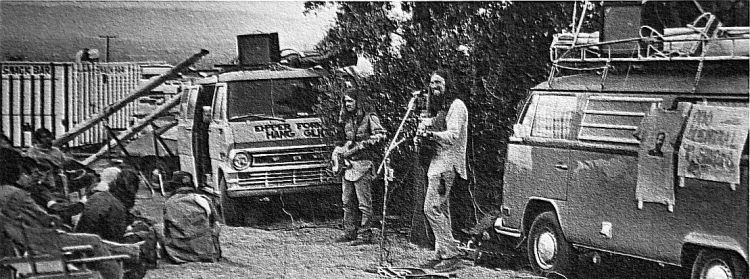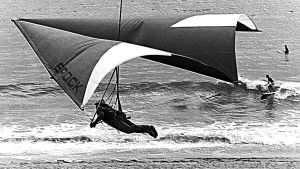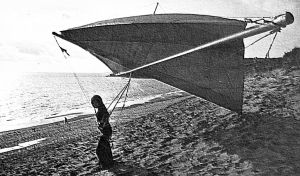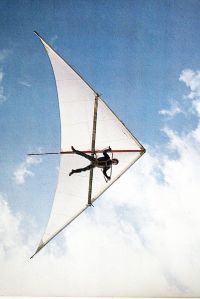Home (contents) → Chronology → Hang gliding 1973 part 1
Hang gliding 1973 part 1
This page continues from Hang gliding before 1973 part 2.
Can you imagine that our first years were spent speeding up and down the mountain roads, making as many 10-minute flights as we could in a day? We got really good at takeoffs and landings!
— Donnita Holland quoted by David Jebb in Hang Gliding & Paragliding, October 2007
The images here are artistic derivations of contemporary photos. See Copyright of early hang gliding photos.
To set the context of world events in 1973, at least from a western ‘first world’ perspective, the last of the moon landings had taken place the previous year and, while the Americans had largely withdrawn from Vietnam, Saigon was yet to fall to the Communists. Britain was beset by energy crises and the ‘population problem,’ the definition of which was vague.

This photo illustrates a technique used by some pilots of the early Rogallo wings: That of using your feet to spread the rear wires and bend the keel tube–and the root area of the sail–into a camber. That increased the lifting efficiency of the wing, but it also reduced its pitch stability. Likely not a problem when flying straight and level in calm air.


Skydiving guru Dan Poynter’s book stood out from the crowd in its comprehensive content, well written and well illustrated. It was neither a ‘bandwagon’ photo book nor a one-sided view from an author connected with a particular manufacturer.
If you are over thirty and want to feel like a senior citizen, just join a crowd of hang glider pilots.
— William Le Mer describing hang gliding in the early 1970s (12)
William Le Mer, then in his fifties while most hang glider pilots were in their twenties (how times change!) was a glider pilot 30 years before; in World War 2. (See the World War 2 related topics menu.) Why take up hang gliding?
Those people who would understand need no explanation, while those who need an explanation would never understand.
Looking up from the landing zone while drinking hot coffee from his thermos in the still morning air…
Saddleback Mountain was sharply outlined against the blue sky and splashed with fall colors.
Le Mer then spotted Kasmer ‘Kaz’ DeLisse, then vice-president of the Southern California Hang Glider Association (which became the USHGA) — a fellow World War 2 veteran. (See later on this page for more of DeLisse.) DeLisse said they were holding a competition and would he like to enter?
While my cool and calculating mind was telling me, “No way will I get into this,” incredibly I heard my voice saying, “Sure, I’d like to go…”
🙂
The van finally stopped and we waited a few minutes until someone came by yelling, “Everyone out!” Everyone tumbled out and I caught my breath. We were standing at the edge of an abyss, several thousand feet deep, on a narrow road cut into the side of the mountain.
Le Mer was first off…
I glanced back at the hill and saw someone stall in and crash on the steep slope.

He found some lift, but eventually encountered sinking air and headed to the LZ.
With a shock, I decided we were barely going to make it! Kicking out of the stirrup, I trundled my numb legs a few times, flared and made a perfect landing in the center of the landing area. With a sigh of relief, I unsnapped my “D” ring and picked up the glider to move it out of the area and make room for the next man. In that moment I heard the strangest noise.
I took note of my surroundings. The landing area was ringed with hundreds of people and they were all clapping!
He was the only one to make the landing zone in his first hang gliding competition, which he ascribed to luck…
So, what made me pound on the steering wheel every few minutes, all the way home, and shout out the window of my ratty old pickup at amazed passersby: “I WON, I WON!”

The original photo of Chris Wills landing at Sylmar was taken by Bill Allen, who was one of a handful of the early photographers and columnists who documented hang gliding in the 1970s. According to the July 1973 edition of Ground Skimmer and the retrospective account in the September 1977 edition of Hang Gliding, the Annie Green Springs event was held on Tuesday 23rd to Thursday 25th October, 1973.
Then we’d talk and laugh about it all around a campfire, drinking hot-spiced wine and roasting hot dogs while John Denver wailed “Rocky Mountain High” on the radio of an old VW bus… That was hang gliding in 1973.
— Mark Sawyer (1)

Chris Price, who is checking the security of the gliders on his Volkswagen in the image, designed the first popular prone harness for hang gliding (that is, lying down Superman style).
In 1973, you stood and walked with your left arm angled out a ways and thumb hooked through a belt loop. Notice also the photographer in the middle…
The parking lot was jammed with cars and RVs, and as we reached the flying site, colored pennants formed into long lines and cheerfully waved at the crowd. Cameras were everywhere: carried by hand, slung around necks, and the oversized variety, bearing the letters NBC, CBS, and ABC, riding sidesaddle on human shoulders.
— Maralys Wills and Chris Wills in Higher than Eagles, 1992. See my review.

See Annie Green Springs 1973 briefing photo key.


Doubtless it occurred to many radio control glider fliers that, if only they built one large enough to sit in, they could become airborne themselves. Radio control glider champion Mark Smith turned that dream into a reality. (Notice the absence of ailerons in this design.) What this image does not reveal is that the pilot was not strapped in! Two video clips under External links later on this page demonstrate that alarming oversight, fortunately without injury. Nine years later, Smith created the Wanderer powered ultralight.

Anthony Matthews was killed flying an Icarus 5 a short time after this photo was taken. Some of his music is used in Bill Liscomb’s 2008 documentary Big Blue Sky. (See under External links later on this page for the David Shoffner interview in Big Blue Sky.)

William le Mer (quoted earlier) was not unique among the older pilots in having fought in World War 2.
It was frightening, lifting up the kite and feeling the wind fill the sail. Trying to keep the kite into wind on an even keel. People staring anxiously at me waiting for me to take off. Nervously glancing over the edge of the slope which was only about thirty feet high. Looked more like a thousand feet high.
— SCHGA flight director Kaz De Lisse, who had landed with the Fourth Marine Division on the volcanic ash moonscape beach of Iwo Jima in February 1945. (6) See also the World War 2 related topics menu.
Fun in the sun

The VJ-24 Sunfun, like its predecessor the VJ-23 Swingwing, was a rigid hang glider with conventional airplane controls. Unlike the VJ-23, the VJ-24 was built using aluminium alloy tube and hang glider fabric. Volmer Jensen, its designer, reckoned it took half as long to build as its predecessor. See the related topics menu VJ day — Volmer Jensen’s hang gliders.


The rigid gliders offered clear advantages over flex-wing Rogallos both in performance and controlability. Yet, by 1973 it had become clear that the Rogallos were much more popular than the rigid wings, which suffered from disadvantage of weight, cost, complexity, more involved transport and assembly, and susceptibility to damage.
In the beginning the Rogallos had another advantage. They were different. What had failed to ignite enthusiasm when it looked like a familiar glider seemed to turn everyone breathless when it looked like a child’s kite.
— Maralys Wills, Manbirds, Prentice-Hall 1981

Brock

Automotive designer Pete Brock (of the Shelby Daytona Cobra Coupe and Corvette Sting Ray) had a go in Russ Velderrain’s bamboo bomber on December 7th, 1971. The fuel crisis struck in 1972 and Brock switched from car design to making parts for hang glider manufacturers. Then he started producing complete hang gliders, at first with Eipper making sails for him and then Seagull making his sails.(3) His firm Ultralight Products was based at a workshop in El Segundo, a few streets away from the Douglas aircraft plant in the low-rise, sun-baked, wire-fenced, tawdry yet high-tech aerospace, defense, and petroleum industrial area bordering the south side of Los Angeles International Airport (LAX) on the coast of California.

Ultralight Products led the field in quality of hardware and purpose-designed machined fittings at that time.

For more of Brock, see the related topics menu Ultralight Products of California and Utah.
Trial and error
A large Rogallo built by Robert Powers had some heavy duty nose plates made of surplus metal. Walking by, my eye was caught by some printing on it which read, “BRACKET, BOMB BAY RECEPTACLES, Boeing Airplane Company, 3-4-53.”
— W.A. Allen writing in Ground Skimmer, May 1973

The Whitney Portawing featured cable leading edges instead of leading edge tubes. It was designed and manufactured by automotive fabricator Eddie Paul. Like Pete Brock, Eddie Paul’s workshop was based in El Segundo on the southern edge of Los Angeles International Airport. (Eipper-Formance was only a few miles away.) See under External links for more about this remarkable individual, who died in 2016.


For color photos of a Whitney Porta Wing, see the Santa Barbara Hang Glider Emporium page.

For more about the glider in the brochure photo, see Seagull 3 later on this page.

U.S. Navy F-4 Phantom pilot Rich Finley designed, built, and flew the Windlord series of Rogallo wings. While the standard Rogallo had an 80-degree nose angle, leading edges and keel of equal length (normally about 18 feet) and four degrees of billow in each side of the sail, the Windlord sported a 92 degree nose angle, 19-foot long leading edges, a keel of only 15 feet, and a flatter sail. (7)
The Windlord 4 eventually metamorphosed into the popular Cirrus 3 made by Electra Flyer of New Mexico. For more about the Cirrus series, see the related topics menu Electra Flyer of Albuquerque, New Mexico.
To fill out my slide shows and photo essays, I turn my cameras on the funky, flashy followers of hang gliding. There must be a hundred ways pilots carry kites on cars. I shoot bumper stickers, T shirts, close-ups of needlework on denims, hang glider jewelry, chicks with hang gliders reflected in their sunglasses, truck loads of kites heading uphill, freaky graffiti (“Do it in the sky”), and every good looking body in sight.
— Stephen McCarroll (10)


Stephen McCarroll not only photographed hang gliders from the ground. He was one of the early hang glider pilots who experimented with cameras mounted on his glider. A few years later, after recovering from injuries sustained in a flying accident, he had Wills Wing build him a hang glider purpose-made for aerial photography.
Because human senses can absorb only so much information, particularly under pressure of flight test, external observation, movie film, and still photography can be of great benefit…
Later the pictures showed unsuspected leading edge flexing and sail creases — which led to the manufacturer’s redesigning his leading edge.
— Stephen McCarroll
In subsequent years, movie cameras were used for analyzing hang glider structures in flight and, later, attached to moving vehicles. See Vehicle-based testing in Tom Price’s flying machines for more.
McCarroll was killed in April 1982 in a powered ultralight crash.(4) See also the related topics menu Photographers of early hang gliding.
Don Dedera wrote Hang Gliding: The Flyingest Flying, 1975, featuring Steve McCarroll’s photos as well as his own. Dedera was a journalist whose assignments included combat reporting from Vietnam. He died in 2020 aged 90.
Seagull 3

In this photo, Curt Stahl, 15, has wriggled in front of the harness risers to provide more reach in the landing flare. Prone harnesses provided that reach, as well as incurring less aerodynamic drag, but flying prone was considered to be more dangerous than flying seated. A six page article by Carol Boenish-Price in Ground Skimmer quoted opinions by several pilots on the merits and drawbacks of both types of harness. See the Harnesses page.
Curt Stahl son of SCHGA Flight Director Chuck Stahl(5), flying either this or another Seagull hang glider, beat the legendary Bob Wills at a subsequent competition held at Escape Country, California. Sadly, he died of head injuries sustained in a crash in November 1973 when “‘…the third of a series of intentional low altitude porpoising maneuvers deflated Curt’s experimental sail and led to a 30 mph crash and fatal brain damage.” (11) Unlike the photo here, he was wearing a crash helmet at the time. (2)
The Seagull had parabolic curved leading edges (the tubes were permanently formed into that shape) to reduce washout (span-wise wing twist). See the related topics menu Seagull Aircraft of Santa Monica, California.
On December 18th 1973, the Southern California Hang Glider Association (previously the Peninsula Hang Glider Club) became the United States Hang Gliding Association.(8) Chris Talbot-Jones designed the logo.(9)


Related
This topic continues in Hang gliding 1973 part 2.
Rogallo wing definitions and diagrams
External links
Anthony Matthews narrated by Bill Liscomb, David Shoffner, and Taras Kiceniuk Jr. in Big Blue Sky by Bill Liscomb on YouTube, starting at 50 minutes 29 seconds. (The rust brown Volkswagen Beetle resembles one used by David Cronk at about this time, although a black and white photo of Cronk’s vehicle shows it to have a glider rack bolted to its body work.)
Chris Wills flying at the Annie Green Springs competition color photo by John G. Zimmerman/Sports Illustrated on Getty Images. Text accompanying this and the other photos by John G. Zimmerman at this event give the date as 11/12/1973. Assuming the U.S. date convention (I wish they wouldn’t do that!) that is November 12th 1973. That might be when the film was developed. My information is that the event was held on 23 to 25 October.
Chris Wills (again) flying at the Annie Green Springs competition color photo by John G. Zimmerman/Sports Illustrated on Getty Images — side view showing the low billow of the Sport Kites Inc. Wills Wing
Eddie Paul: The Nemesis by Eddie and Renee Paul (Amazon bookstore)
Japan’s first hang glider 1972~1973, digitized film on YouTube starting at 7 minutes 27 seconds
LIFT interviews Eddie Paul on rentatrip1’s YouTube channel
Mark Smith flying his scaled up radio control glider: Big Blue Sky by Bill Liscomb, starting at 39 minutes 45 seconds with Donnita Holland narrating (not specific to this glider). See also the longer, but lower resolution equivalent in Wings of the Wind, linked farther on.
Remembering Don Dedera, distinguished ASU alumnus on Arizona State University news. Dedera wrote Hang Gliding: The Flyingest Flying, 1975, featuring Steve McCarroll’s photos as well as his own.
Standard Rogallo (unidentified pilot) at the Annie Green Springs competition color photo by John G. Zimmerman/Sports Illustrated on Getty Images
Wings of the Wind video external links
A mid-1970s documentary by Gib Jaffe on YouTube
- General flying and rigging: Wings of the Wind starting at 3 minutes 13 seconds, including Jack Schroder rigging his Quicksilver
- Jack Schroder and his Quicksilver again: Wings of the Wind starting at 16 minutes 41 seconds
- Mark Smith flying his scaled up radio control glider: Wings of the Wind starting at 29 minutes 15 seconds. It is of lower resolution than the clip in Big Blue Sky, but it includes more of the flight and is correspondingly more scary.
- Point Fermin cliff: Wings of the Wind starting at 19 minutes 28 seconds, for Jack Schroder in his Quicksilver and, later, Taras Kiceniuk narrating
- Point Fermin cliff: Wings of the Wind starting at 22 minutes 55 seconds to see an in-flight movie camera on the glider’s base tube
- Volmer Jensen interview: Wings of the Wind starting at 11 minutes 12 seconds
References
1. Mark Sawyer, The History of Hang Gliding; a Personal View of a Collective Experience in Sky Adventures, Legends and stories About the Early Days of Hang Gliding and Paragliding edited by Jim (Sky Dog) Palmieri and Maggie Palmieri, 1998
2. Curt Stahl is included in the list of fatalities in Ground Skimmer, January 1975 (number 41 on page 36). On page 29 of the June edition, R.V. Wills mentions briefly Stahl’s crash.
3. An Interview with Pete Brock by Dan Johnson, Whole Air magazine, July-August 1980
4. Dan Johnson, Product Lines, Whole Air No. 24 May-June 1982
5. Curt Stahl was son of Chuck: Jack Lambie writing in Ground Skimmer, June 1973
6. Kasmer De Lisse, Ground Skimmer, June 1973
7. Windlord, a sketch in time by Bob Skinner, Ground Skimmer, March 1975
8. Vic Powell writing in Hang Gliding September 1991
9. Chris Talbot-Jones designed the logo: Post on May 19, 2015, by Neil Larson on US Hawks forum
10. Stephen McCarroll, How to Photograph the Newest Form of Bird, Ground Skimmer November 1975
11. Curt Stahl fatality: Hang Gliding: The Flyingest Flying, Don Dedera, 1975
12. Hang Gliding Nostalgia, the Mountain by William Le Mer, Hang Gliding, September 1983
I believe the first view I had of a hang glider was in 1973. I believe it was in the magazine, “popular mechanics”, but I could be wrong. But the image of a man suspended above a hill on a flying contraption captured my attention. Within a few weeks I had located an instructor/manufacturer in Southern California at Free Flight systems in Sylmar California. Rico Blair agreed that he would travel to San Bernardino California from Sylmar if I could round up a dozen individuals that might be interested in flying hang gliders. So I was able to round up a gang of individuals that thought they would give it a try. So Rico shows up with a couple training gliders at a hill I had found that would be suitable to beginning to learn the sport of hang gliding. It was quite a day with many of the individuals not having great success. Lots of skinned knees and elbows. But no serious injuries. I had three or four perfect launches and landings. Indeed flaring and landing on my feet. So…. the next question was, How soon can I buy a hang glider? Within a weak I was owning and flying my own hang glider off of “Little Mountain” in San Bernardino, CA. I had also become and instructor and got a few dozen individual taking lessons and purchasing gliders. It was a fantastic time as we were truly pioneers. I am now 69 and had my last flight about a month ago. It was a fantastic flight. My reason for eventually exiting from hang gliding was primarily health issues that not only was effecting my physical health, but also my mental health.
LikeLike